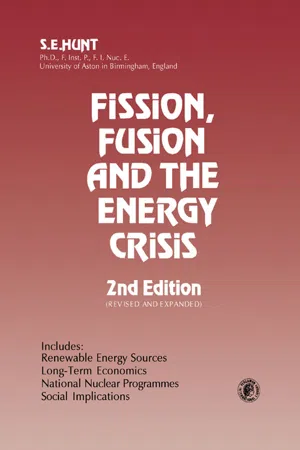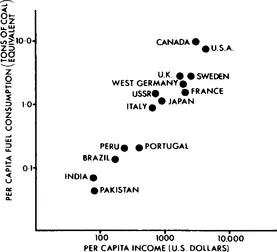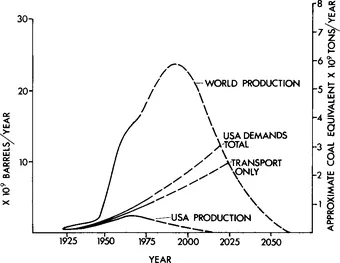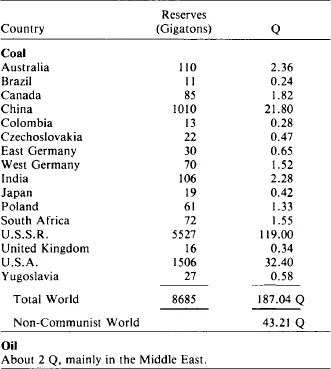![]()
CHAPTER 1
Living on Capital
Publisher Summary
In financial circles and even in the management of our personal affairs, to live from accumulated capital reserves is not a well-advised procedure, yet this is being done in the consumption of fuel to produce electricity and other forms of power on which our present standard of living is dependent. This chapter discusses the power requirements and available fuel supplies on a global scale and explains that the unit Q has been chosen to measure the energy produced by burning 46,500 million tons of coal, producing approximately 300 billion kilowatt hours of electrical energy. It is estimated that from the birth of Christ to the beginning of the industrial revolution, the world consumption of energy was approximately 4Q. This was principally produced by burning wood and animal refuse, and during this time, little, if any, use was made of the capital resources of coal, oil, natural gas—the fossil fuels—which had been accumulated since prehistoric times. Future predictions of fuel requirements are very difficult; the main factors affecting these are clearly the growth of world population and improvements in the standard of living, because, in the utilization of conventional fuels at least, any dramatic improvement in the efficiency at which fuel is converted into energy cannot be reasonably expected.
IN FINANCIAL circles and even in the management of our personal affairs, to live from accumulated capital reserves is not regarded as a very satisfactory procedure, yet we are doing exactly this in the consumption of fuel to produce electricity and other forms of power on which our present standard of living is critically dependent.
In order to discuss the power requirements and available fuel supplies on a global scale, we must define a suitable unit. Economists have chosen the unit ‘Q’, which is equivalent to the energy produced by burning 46,500 million tons of coal, producing approximately 300 billion (3 × 1014) kilowatt hours of electrical energy. This is, of course, an extremely large unit, but an appropriate one for estimating our present and future requirements. Perhaps the most significant factor to be considered is the rate at which these requirements have grown throughout our history. It is estimated that from the birth of Christ to the beginning of the Industrial Revolution, about A.D. 1850, the world consumption of energy was approximately 4 Q. This was principally produced by burning some of the current year’s growth of wood and animal refuse, and during this time little, if any, use was made of the ‘capital resources’ of coal, oil, natural gas, etc., the so-called fossil fuels which had been accumulated since prehistoric times due to under-exploitation of growing fuel sources. These capital reserves were in fact continuing to accumulate during this period. By 1850 we were using fuel at the rate of some 1 Q per century, and a hundred years later, in 1950, the consumption had increased to approximately 10 Q per century. In 1970 alone we used approximately 0.2 Q, that is the rate was approximately double that in 1950, and immediately before the oil crisis the world energy demand was increasing with a ten-year doubling time. Forward predictions of fuel requirements are notoriously difficult; the main factors affecting these are clearly the growth of world population and the improvement in the standard of living, since, in the utilisation of conventional fuels at least, we can no longer reasonably expect any dramatic improvement in the efficiency at which fuel is converted into energy.
Per capita fuel consumption is very closely linked with the material standard of living. In round terms the average income in the United States is twice that in Western Europe, which, in turn, is some fifteen times greater than that in India, and the per capita fuel consumptions vary in almost exactly the same ratios. A similar relationship exists for countries between these limits, as shown in Fig. 1. It is perhaps pointless to argue whether the ready availability of fuel has led to a high standard of living or whether the desire for a high standard of living itself has generated the need for and development of high fuel consumption. This is a traditional ‘hen and egg’ situation. The relevant fact is that fuel consumption and standard of living go hand in hand, so that in predicting our future fuel requirements, some estimates of future standards of living are clearly called for. In the ‘developed’ countries such as the United States, Canada, Western Europe, etc., the average standard of living is still improving and the per capita fuel consumption appears to increase relentlessly at the rate of about 3% per year. Such is the economic balance that increases of slightly less than this figure coincide with periods of economic depression, slightly greater increases with periods of economic boom. Even in developed countries there does not appear to be as yet any saturation point at which power and fuel consumption may be expected to level off at a figure corresponding to some finally acceptable standard of living. For future planning, one possible postulate is that the world demand for fuel will increase continuously at a rate of 3% per head per annum as in the developed countries. When one considers that most of the large centres of population need to increase their national income and per capita fuel consumption by at least a factor of 10 before they reach a level of material comfort which we now regard as barely acceptable, it is clear that, for social and ethical reasons, there is strong argument that the world per capita fuel consumption should increase at a rate far in excess of 3% per annum even if it were to be frozen at present levels in developed countries.
FIG. 1 Income vs. fuel consumption (mainly 1972 figures).
Predictions of the growth of world population must also be uncertain. The early assumption that it would increase by a factor of 3 between 1950 and 2050 appears, in 1978, to be partially justified. The world population doubled in the previous century (1850–1950) in spite of two world wars and the relatively limited application of medical science.
Based on the above possibly conservative predictions, the world energy requirement between now and A.D. 2050 is estimated to be about 70 Q. Since this is many times greater than the world’s energy consumption to date, it is relevant to examine our energy resources in some detail. As has already been indicated, these may be divided into two categories, the renewable sources, that is the energy which we receive each year, and the capital reserves which have accumulated in previous centuries when supplies exceeded demand.
Appreciable use was made of renewable energy sources before the Industrial Revolution, when wind and water power, albeit in a rudimentary form, were widely used and wood was the main fuel. With the Industrial Revolution coal became the main energy source, to be supplanted to a greater or lesser extent in many countries by ‘cheap oil’ from the Middle East in the post-war era.
The dramatic increase in oil prices in 1974 forced some reappraisal of this situation but the fundamental problem is not one of price but of overall reserves. The estimated global oil reserves are comparatively small, probably less than 2 Q, and despite the importance of the new North Sea fields to the British economy the rate of discovery of new oil reserves on a global basis has been falling steadily over the past twenty years whilst oil consumption still continues to grow despite the economies in its use by some industrial nations. The steady fall in the ratio of new discoveries to current consumption leads to an estimated peak in oil consumption in the early 1980s followed by a decline dictated by the exhaustion of the overall oil reserves.
In the early 1980s it is anticipated that approximately 55% of the total oil production will be in the Middle East, 20% in the United States, perhaps 7% from the North Sea fields and 18% from the rest of the world. This excludes oil production from the Communist countries. The oil shortage in the late eighties could be quite dramatic unless much more severe measures are taken to restrict its use as a fuel to those applications in which it has a clear advantage over other energy sources. Despite its comparatively high domestic production the United States is already an oil–importing nation and a realistic extrapolation of the American current consumption trends indicate that they would be capable of consuming the total free world oil production by the year 2020 (Fig. 2). It is clear that a move from oil as a main energy source is both desirable and urgent. Almost paradoxically whilst large quantities of oil are still being used to power electricity generating plant many countries are devoting considerable research effort into the problem of converting coal into a liquid fuel. This is intended to replace petrol in the specialised field of motor transport as the oil reserves become exhausted.
FIG. 2 Oil production and demand.
The coal reserves, viewed on a global basis, are in an appreciably healthier state than are the oil reserves. World reserves of mineable coal are estimated at about 8700 Gigatons * (or, say, about 190 Q), but as shown in Table 1 only Western Germany and the United Kingdom amongst the industrial countries of Western Europe hold significant reserves. The major coal reserves are in the U.S.S.R., U.S.A. and China which are remote from the Western European countries and many of the developing countries, so that the cost of transporting fuel, whether expressed in financial or energy terms, would be excessive. To transport coal, for example, from Siberia, where many of the Russian reserves are situated, to Western Europe would require a railway or other transport system far in excess of the existing one, and an appreciable fraction of the cargo would be consumed in transit. Reliance on coal as a long-term energy source could clearly pose appreciable economic and practical problems, even if political factors are ignored.
TABLE 1
Estimated World Fuel Consumption and Fossil Fuel Reserves
*Q≡46,500 million tons (46.5 Gigatons) of coal equivalent.
The so-called ‘renewable’ energy sources would in principle avoid the large-scale depletion of our capital fuel reserves. These involve harnessing the vast quantity of solar energy, about 5000 Q per year falling on the earth’s surface, either directly or via its indirect manifestations such as wave and wind power, and will be discussed in greater detail in Chapter 11. Attractive as they are in principle it seems unlikely that the renewable energy sources can be developed to meet a large fraction of the demand of an advanced civilisation. We must therefore continue to exploit our capital reserves, but this must be done with a greater regard to the long-term energy situation rather than just their immediate economically competitive position. This is particularly true of the other large capital energy reserve, fissile material. Here the situation is more complicated and, as explained in Chapter 7, rapid and uncontrolled exploitation could reduce the overall fuel value of our fissile reserves...




